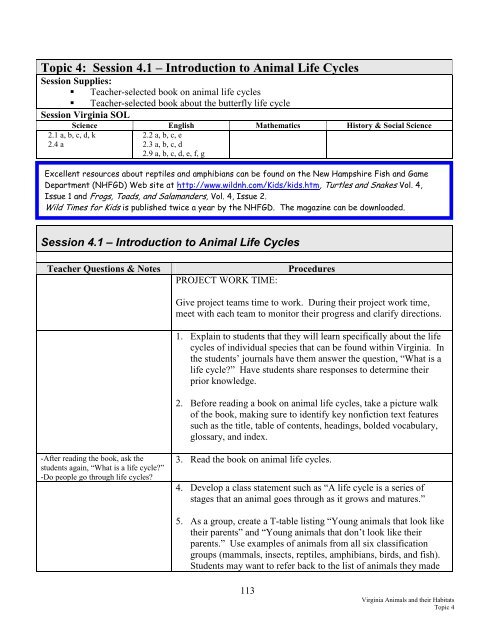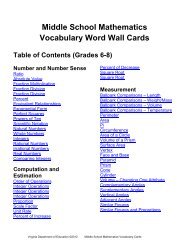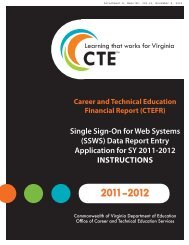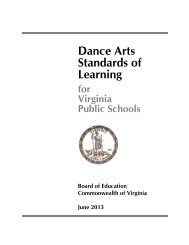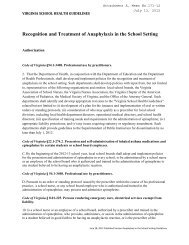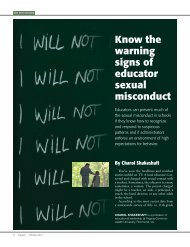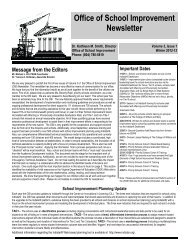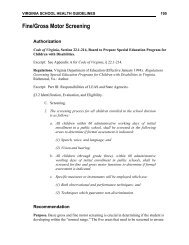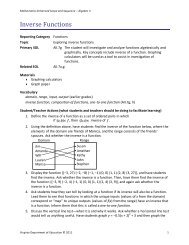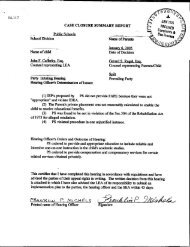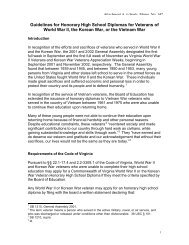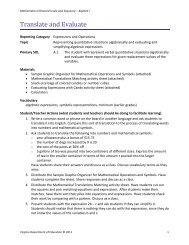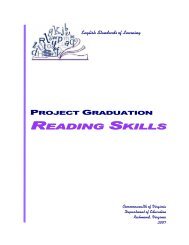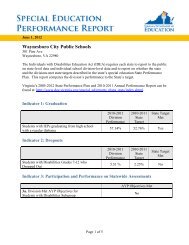What Makes Something Alive - Virginia Department of Education
What Makes Something Alive - Virginia Department of Education
What Makes Something Alive - Virginia Department of Education
Create successful ePaper yourself
Turn your PDF publications into a flip-book with our unique Google optimized e-Paper software.
Topic 4: Session 4.1 – Introduction to Animal Life Cycles<br />
Session Supplies:<br />
• Teacher-selected book on animal life cycles<br />
• Teacher-selected book about the butterfly life cycle<br />
Session <strong>Virginia</strong> SOL<br />
Science English Mathematics History & Social Science<br />
2.2 a, b, c, e<br />
2.3 a, b, c, d<br />
2.9 a, b, c, d, e, f, g<br />
2.1 a, b, c, d, k<br />
2.4 a<br />
Excellent resources about reptiles and amphibians can be found on the New Hampshire Fish and Game<br />
<strong>Department</strong> (NHFGD) Web site at http://www.wildnh.com/Kids/kids.htm, Turtles and Snakes Vol. 4,<br />
Issue 1 and Frogs, Toads, and Salamanders, Vol. 4, Issue 2.<br />
Wild Times for Kids is published twice a year by the NHFGD. The magazine can be downloaded.<br />
Session 4.1 – Introduction to Animal Life Cycles<br />
Teacher Questions & Notes<br />
PROJECT WORK TIME:<br />
Procedures<br />
Give project teams time to work. During their project work time,<br />
meet with each team to monitor their progress and clarify directions.<br />
1. Explain to students that they will learn specifically about the life<br />
cycles <strong>of</strong> individual species that can be found within <strong>Virginia</strong>. In<br />
the students‟ journals have them answer the question, “<strong>What</strong> is a<br />
life cycle?” Have students share responses to determine their<br />
prior knowledge.<br />
2. Before reading a book on animal life cycles, take a picture walk<br />
<strong>of</strong> the book, making sure to identify key nonfiction text features<br />
such as the title, table <strong>of</strong> contents, headings, bolded vocabulary,<br />
glossary, and index.<br />
-After reading the book, ask the<br />
students again, “<strong>What</strong> is a life cycle?”<br />
-Do people go through life cycles?<br />
3. Read the book on animal life cycles.<br />
4. Develop a class statement such as “A life cycle is a series <strong>of</strong><br />
stages that an animal goes through as it grows and matures.”<br />
5. As a group, create a T-table listing “Young animals that look like<br />
their parents” and “Young animals that don‟t look like their<br />
parents.” Use examples <strong>of</strong> animals from all six classification<br />
groups (mammals, insects, reptiles, amphibians, birds, and fish).<br />
Students may want to refer back to the list <strong>of</strong> animals they made<br />
113<br />
<strong>Virginia</strong> Animals and their Habitats<br />
Topic 4


